09/27/2020
At McDonald’s, suggestive selling is, “Would you like fries with that quarter pounder?”. Another form of suggestive selling is pulling up at a customer’s house with a flatbed trailer to drop off a new snow blower, that is sharing space with a bright red, brand new, Massey Ferguson sub compact tractor… bucket loader and back hoe attached. Fortunately, my wife was with me, to remind me I did not farm, I had no plans for woodland clearing and I had not yet talked or worn the new off of the bright yellow snow blower. OK, there is that, but…
Lunch time conservation was not as rewarding as might be expected, even though it was my day to pick the discussion topics. “Snow blowers; yellow or orange?”, “Snow blowers; electric start or manual?” “Snow blowers; two stage or three?”, “Snow blowers; why is the new snow blower so damn good looking?”. The crowd thinned after the electric/manual start method question until only my wife remained, but I noticed she was playing Yahtzee on her iPhone. So I went out to the garage, fired up the snow blower… manual start, and took a few laps on the driveway.
And then there are other toys…
The purpose a firearm serves is determined by circumstances and the hands that hold it. There is no doubt in my mind that the Ruger AR-556MRP is exceptionally good at providing security and defense. There is no doubt in my mind that the Ruger AR-556 can put food on a table up through deer size game.There is, however, also no doubt in my mind that the Ruger AR-556 can provide days on end of recreational target shooting and an outlet for mad scientist handloaders that are always working toward the unattainable, optimal round. No doubt, another centerpiece for many lunch time conversations.
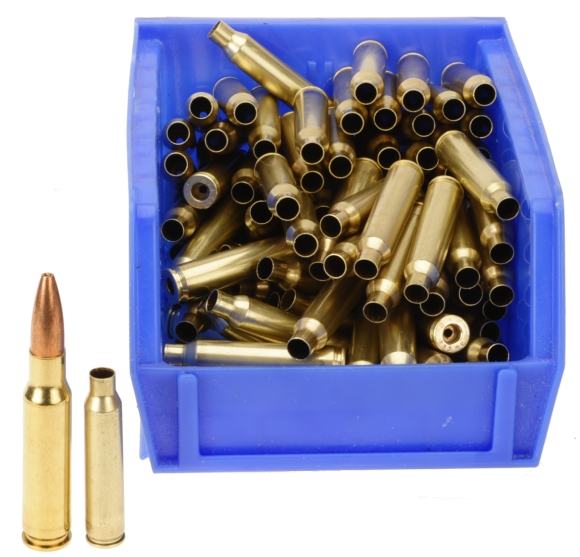
Above, 223 Rem brass next to 308 Win cartridge for the sake of comparison. One of the reasons stated in Part I for selection of the Ruger AR-556 in 5.56 NATO is the rounds light weight and compact size. That is over one hundred casings in that small bin, not much more than a pocket full, but more than three 30 round magazines full.
The brass used within this project were all Winchester, once fired, sonic and walnut medium cleaned, full length sized, trimmed, and chamfered. RCBS small base dies were used with crimping done with a Lee collet crimping die. Why? I shoot a good deal with a silencer in place, which makes for chamber carbon residue. Small base dies are a way to ease the burden on autoloader cycling. Is this necessary? No. I am just overly cautious. A batch reloading process was employed and all charges were individually weighed.
Small magnum rifle primers were used across the board. In days past, while running pressure tests with a universal receiver and conformal transducer gear, magnum primers created a slightly higher initial pressure, with negligible impact on average pressure and with a shot to shot pressure consistency much like that of bench rest primers. So…
Smokeless powder selection
There are some similarities in powder characteristics and it may very well be that two different branded containers may contain the exact same powder. See discussions related to Hodgdon H414 vs Win 760. My perspective is that while reloaders may deem powders to be the same and load accordingly, manufacturers are not held to those performance standards. Subsequently shifts in vendors, locations of processing facilities, additives, and specific powder composition can vary. In fact, where powders may be suspected as being the same, and charges are the same, velocity differs significantly. But then you know that because you pay attention to those product cautions and you are a safe handloader. So a reference to a powder types here is literal as indicated.
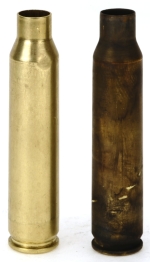 The Ruger AR-556 MPR was shot with and without silencer. Soot, smudges and scope optic flushing became the earmarks of the former as is always the case. In both configurations, functional reliability was absolute, with one exception.
The Ruger AR-556 MPR was shot with and without silencer. Soot, smudges and scope optic flushing became the earmarks of the former as is always the case. In both configurations, functional reliability was absolute, with one exception.
The AR-556 was quite quiet even in the presence of a clacking action and diminutive sonic boom. However, there is no way to hang a silencer on a firearm and not offer at least one subsonic listing.
In this case, the 55 grain load produced a very consistent 1,100 fps result, which should have been marginal as a subsonic round, but in fact was exceptionally quiet. However, no effort was made to accommodate this round by reconfiguring the AR-556 or silencer mounting, so it performed reliably, but did not cycle the action.
I intended to pick nits with Ruger until I receive a rational explanation as to why a 223 Rem AR has an AR barrel length of 16.1″ and a 300 Blackout barrel length is listed as 16.38″. My working theory is that this length is determined by the barrel’s taper and at what length the muzzle is the right diameter, by caliber, to accept threads, sight bands or whatever else is to be done at the barrel end.Yes, I do know what nominal length means, but that does not explain the differences. What does this have to do with anything? Not a thing.
And then there were nine…
Joe, why the hodgepodge of bullets? Ruger indicates that the Ruger AR-556 1:8″ 5R rifling will accurately handle bullet weights from 35 grain to 77 grains. Yes, Ruger is rifle with engineers, but why would you say that? If they had said 75 grains or 80 grains I would have left it alone and moved on to other areas, but that “77” stuck with me and I had to explore. If I got to 78 or even 80 grains, what would happen?
So the stubbiest 35 grain bullets were selected from 22 Hornet bullet inventory, and a couple of heavyweight and very long match bullets (A-Max since displaced by ELD product) from a quick twist 22-250 Rem bullet inventory, knowing that if a marketing claim scandal were to be uncovered, this would flush it out.
Warning: Bullet selections are specific, and loads are not valid with substitutions of different bullets of the same weight. Variations in bullet length will alter net case capacity, pressure and velocity. Primer selection is specific and primer types are not interchangeable. These are maximum loads in my firearms and may be excessive in others. All loads should be reduced by 5% as a starting point for development where cartridges have greater than 40 grains in capacity and 10% for cartridges with less than 40 grain capacity following safe handloading practices as represented in established mainstream reloading manuals. Presentation of these loads does not constitute a solicitation for their use, nor a recommendation.

| Cartridge |
223 Remington |
| Firearm | Ruger AR-556 |
| Barrel Length | 16.1″ |
| Max Case Length | 1.760″ +0.0″/-0.030″ |
| Min- Max COL |
2.125″ Min – 2.260″ Max |
| Primer | CCI 450 SMR |
| Bullet Diameter | 0.2245″ +0.0″/-0.0030″ |
| Reloading Dies | RCBS F/L Lee Crimp |
| Bullet Type | Bullet Weight Grains |
Net H2O Grains Capacity |
COL” | Powder Type | Powder Charge Grains |
Muzzle Velocity fps |
Muzzle Energy ft/lbs |
100 Yd 3 Shot Group” |
| Hornady V max | 35 | 27.3 | 2.125 | Re7 | 24.5 | 3523 | 965 | 7/8 |
| Hornady V max | 35 | 27.3 | 2.125 | H335 | 28.5 | 3579 | 996 | 3/4 |
| Hornady V max | 35 | 27.3 | 2.125 | X-Terminator | 28.4 | 3467 | 934 | 5/8 |
| Nosler Varmageddon | 35 | 27.3 | 2.125 | Re7 | 24.5 | 3529 | 968 | 5/8 |
| Nosler Varmageddon | 35 | 27.3 | 2.125 | H335 | 28.5 | 3579 | 996 | 3/4 |
| Nosler Varmageddon | 35 | 27.3 | 2.125 | X-Terminator | 28.4 | 3414 | 906 | 1/2 |
| Sierra Varminter | 40 | 27.3 | 2.175 | Re7 | 24.0 | 3424 | 1042 | 5/16 |
| Sierra Varminter | 40 | 27.3 | 2.175 | H335 | 28.0 | 3439 | 1051 | 1/2 |
| Sierra Varminter | 40 | 27.3 | 2.175 | X-Terminator | 28.2 | 3305 | 970 | 7/8 |
| Remington PSP | 55 | 26.1 | 2.185 | AR-Comp | 24.5 | 2949 | 1062 | 1/2 |
| Remington PSP | 55 | 26.1 | 2.185 | BL-C2 | 27.5 | 3045 | 1133 | 1.0 |
| Remington PSP | 55 | 26.1 | 2.185 | IMR 4198 | 21.0 | 2958 | 1069 | 3/4 |
| Remington PSP | 55 | 26.1 | 2.185 | Trail Boss | 4.0 | 1100 | 148 | 1 1/2 |
| Nosler Partition | 60 | 25.9 | 2.260 | AR-Comp | 24.0 | 2866 | 1095 | 3/8 |
| Nosler Partition | 60 | 25.9 | 2.260 | Norma 201 | 24.5 | 2813 | 1055 | 1/3 |
| Nosler Partition | 60 | 25.9 | 2.260 | RS TAC | 26.0 | 3039 | 1231 | 5/8 |
| Winchester Power Point | 64 | 25.6 | 2.260 | AR-Comp | 23.5 | 2696 | 1033 | 5/8 |
| Winchester Power Point | 64 | 25.6 | 2.260 | BL-C2 | 26.0 | 2757 | 1080 | 7/8 |
| Winchester Power Point | 64 | 25.6 | 2.260 | RS TAC | 25.5 | 2896 | 1192 | 1/2 |
| Sierra Game King | 65 | 25.6 | 2.260 | AA 2495 | 24.0 | 2710 | 1060 | 1/2 |
| Sierra Game King | 65 | 25.6 | 2.260 | AR-Comp | 23.3 | 2766 | 1105 | 5/8 |
| Sierra Game King | 65 | 25.6 | 2.260 | CFE 223 | 27.0 | 2894 | 1209 | 3/8 |
| Hornady A-Max* | 75 | 24.8 | 2.390 | AA2495 | 22.5 | 2486 | 1029 | 3/4 |
| Hornady A-Max* | 75 | 24.8 | 2.390 | Re15 | 23.5 | 2453 | 1002 | 3/4 |
| Hornady A-Max* | 75 | 24.8 | 2.390 | CFE 223 | 25.5 | 2695 | 1210 | 5/8 |
| Hornady A-Max* | 80 | 23.9 | 2.390 | AA2495 | 21.5 | 2409 | 1031 | 7/8 |
| Hornady A-Max* | 80 | 23.9 | 2.390 | CFE 223 | 24.5 | 2550 | 1155 | 5/8 |
| Hornady A-Max* | 80 | 23.9 | 2.390 | Norma 203B | 23.0 | 2483 | 1095 | 3/8 |
| * Hornady lists these at 2.390″ COL, above SAAMI Maximum and too long to feed through a standard magazine. |
||||||||
Observations/comments…
It seems when I began reloading 223 Remington ammunition there were a good number of compressed loads.Better powder choices, optimized for the 223 Remington round, have all but removed that issue.
Velocity may seem a bit lower than data appearing in mainstream reloading manuals. That would be attributed to the short barrel where mainstream manuals may cite 37 1/2″ long barrels to show the company’s component bullets in the best light… “Our 20 grain bullet left the 37 1/2″ barrel’s muzzle at an astounding 9,000 fps…”.
AR Comp did well in terms of accuracy, but fell short in velocity at reasonable charge levels. CFE 223 did very well in mid to heavier bullet ranges. Norma did better in delivering velocity than it typically does with other cartridges. Both TAC and H335 were standouts.
The little 35 grain bullets require careful handling to start into case mouths while avoiding tipped axis starts and accordion like case necks.
With the exception of the way over COL spec 75 and 80 grain loads, and the aforementioned subsonic load, all feed reliably from the rifle’s magazine and cycled the action reliably.
Targets representative of bullet weight range performance
The 100 yard group pictured below offer some idea of the Ruger AR-556 MPR’s accuracy potential in various bullet weights from light to heavy. These were the best groups shot by weight, but not by much of a margin.
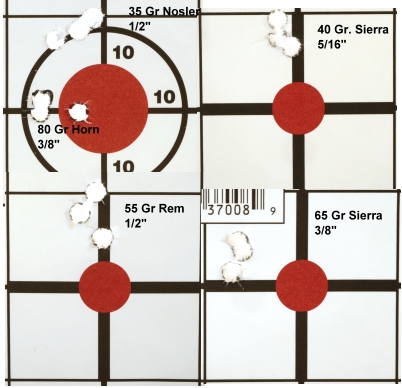
The gratuitous subsonic round shot 1 1/2″. Gratuitous only in the sense that a subsonic 223 Remington or 5.56 NATO round makes little sense. If subsonic projectile velocity is limited to approximately 1,100 fps, why do that with a relatively light 0.224″ bullet when you can easily hit the same velocity with a 220 grain 0.308″ caliber bullet?
The heavier 0.308″ bullet has a much higher ballistic coefficient, a much high sectional density and retains its good ballistic characteristics over a much longer distance. A justification for the 300 Blackout. So why the silencer in this article, Joe? Yeah, what he said! Because even though not whisper silent, noise levels are greatly reduced, which preserves hearing and a good relationship with neighbors.
Finis
I am sure that when I began writing this, I had your best interests at heart. You know, information to share? Unfortunately, as the days wore on and handloading and shooting ensued, I kind of forgot about you as I was having too much fun. I apologize… deeply sorry… Yes, I do feel very bad about it. So if we are about wrapped here, you won’t mind if I just duck out and get back to shooting.

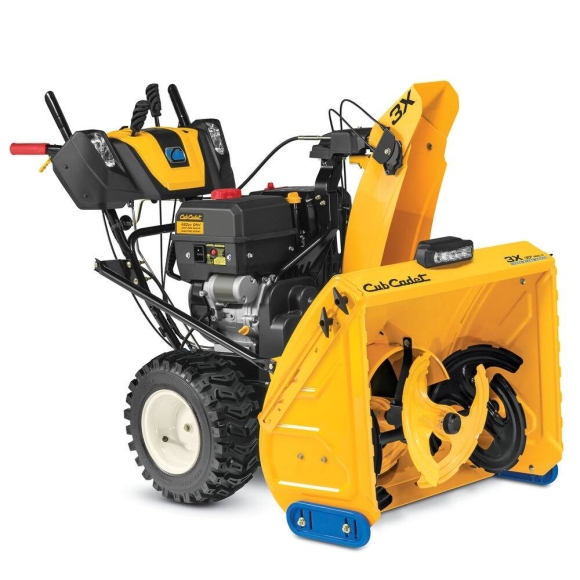

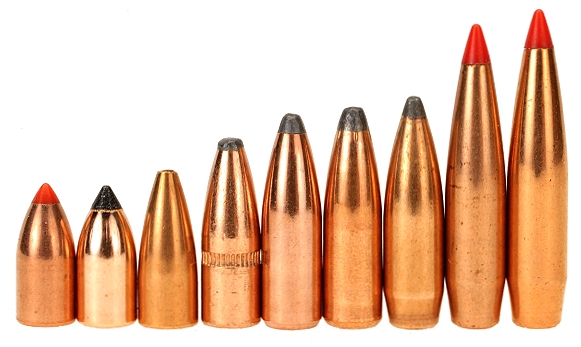
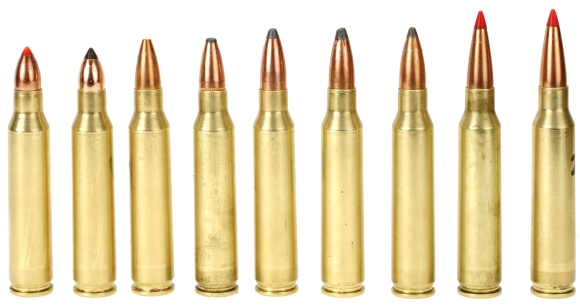
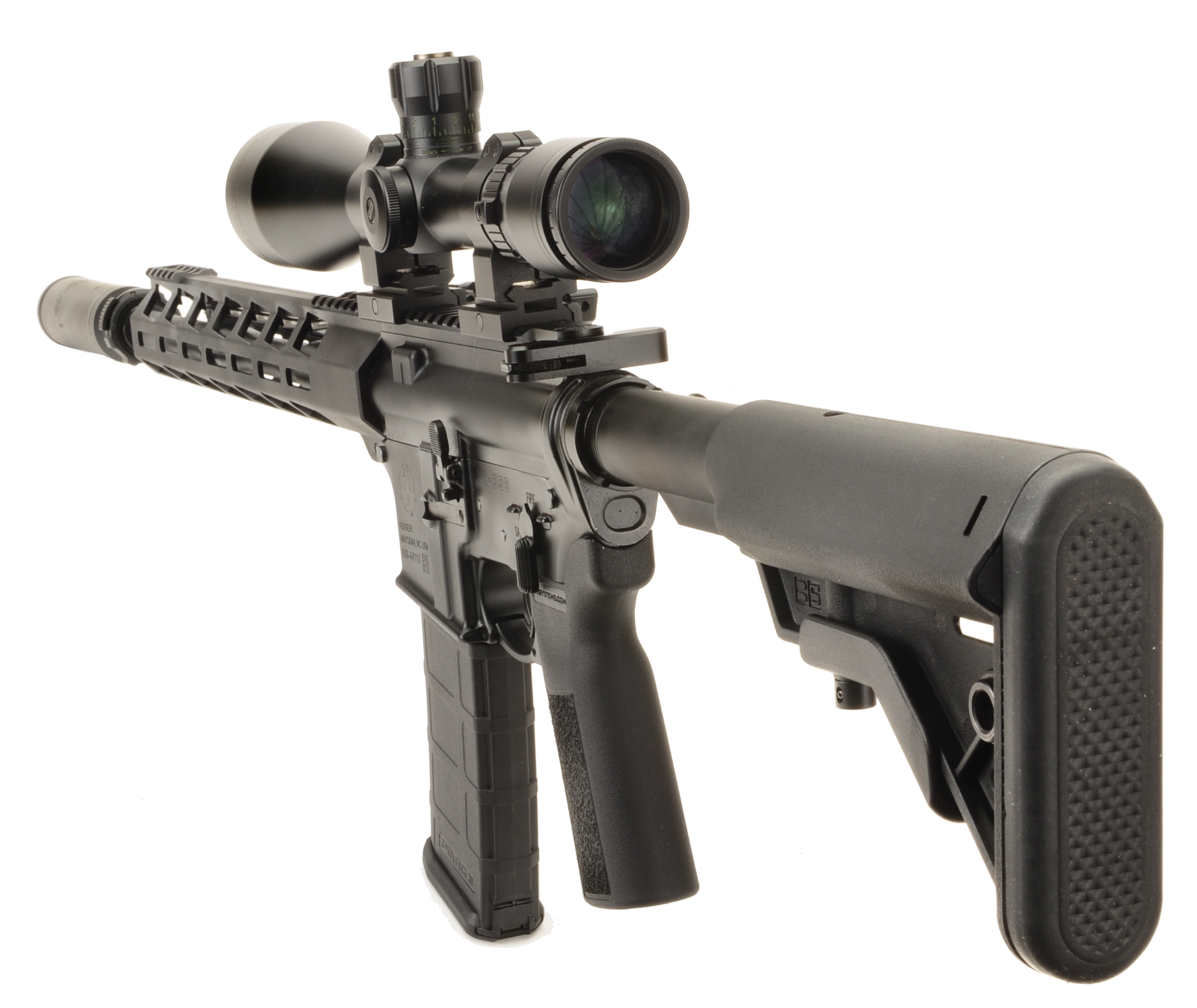
Email Notification